When hiking on packed snow or icy conditions, traction spikes aren’t just a “nice to have” item. They should be considered an essential piece of safety gear. And, yes, there really is a difference between brands of microspikes. The last thing you want is to have your traction spikes fail on you during the middle of a hike in the backcountry.
Here, I will focus on microspikes for hiking. For that reason, you’ll notice that traction systems like Yaktrax (which are only suitable for tasks like shoveling snow in your driveway) are not included.
*If you aren’t sure about how to choose traction spikes, click here to jump down to buyer’s guide. It goes over the types of traction spikes, materials, why some spikes cost so much, and more essential info.
Quick Picks:
- Best Overall: Hillsound Trail Crampons
- Best for mixed conditions: Kahtoola EXOspikes
- Best for Trail Runners: Black Diamond Distance Spikes
- Best Budget Option: Cimikz Traction Spikes
Comparison Table
| Spike Length | # of Spikes (Each) | Weight (Pair) | Spike Material | Base | Velcro Strap | |
|---|---|---|---|---|---|---|
| Hillsound Trail Crampon | 0.59" | 11 | 15.7oz | Carbon steel | Hybrid | Yes |
| Kahtoola Microspikes | 0.375" | 12 | 11oz | Stainless steel | Chains | No |
| Black Diamond Distance Spike | 0.313" | 14 | 6.7oz | Stainless steel | Chains | No |
| Hillsound FlexSteps Traction System | 0.25" | 18 | 12.7oz | Stainless steel | PU plate | Yes |
| Kahtoola Exospikes | 0.29" | 12 | 7.3oz | Tungsten carbide | Hybrid | No |
| Snowline Chainsen Light | 0.3" | 12 | 7.4oz | Stainless steel | Chains | No |
| Cimkiz Snow Grips | 0.5" | 19 | 17oz | Stainless steel | Chains | Yes |
Best Traction Spikes Reviewed
1. Hillsound Trail Crampons
Best for: Overall best traction spikes for hiking
Specs:
- Number of Spikes (per foot): 11
- Spike length: 0.59”
- Weight (pair): 15.7oz
- Base: Hybrid
- Available at: REI and Amazon
Review:
Despite its name, these are actually microspikes and not true crampons. They are regularly picked as the best hiking microspikes for several reasons. The main reason is because these are designed to stay in place well. There is a Velcro strap over the toe area which really helps get a perfect fit. It prevents snagging and keeps the spikes from moving around. You won’t have to annoyingly readjust your crampons as you hike.
The quality of the Hillsound Trail Crampons also stands out. You don’t have to worry about the elastomer harness s breaking and it’s stretchy enough to get on easily.
If you look carefully at the sole, you’ll notice that there is a steel plate on the heel and toe area. This connects the spikes. Compared to chains, the plates do a better job of keeping the spikes in place and make the traction stronger. It also holds the devices flush with your foot better than designs which use chain links.
Pros:
- Great traction
- Spikes stay in place
- Very durable
- Easy to get on/off
Cons:
- Heavy
Hillsound Trail Crampon vs. Pro and Ultra
Hillsound also makes “Pro” and “Ultra” versions of these traction spikes. The key differences are:
- Pro version has much larger spikes of ¾” to 1”. These are heavy but for serious climbing on icy terrain.
- Ultra version has 18 spikes. They are variable in length with most of them being ½”. It doesn’t provide as much traction as the original version. The spikes are made of hardened stainless steel, so it’s better if you need them where salt is used.
2. Kahtoola Microspikes
Best for: Tried and tested quality
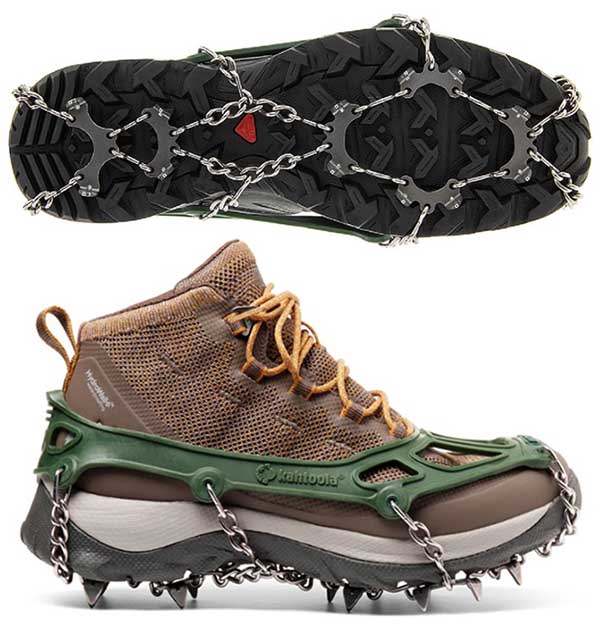
Specs:
- Number of Spikes (per foot): 12
- Spike length: 0.375”
- Weight (pair): 11oz
- Base: Chains
- Available at: REI and Amazon
Review
Kahtoola is by far the best-known brand of traction spikes. They’ve been around for a long time and have a huge following. The quality is tried-and-tested: There are countless hikers who have only tried Kahtoola Microspikes simply because the pair they bought years ago is still going strong.
Just because Kahtoola Microspikes are the most popular option, it doesn’t necessarily mean they are the best though. There are reports of the newer models being cheaply made (at least compared to the previous models). Even if the craftsmanship has dropped, Kahtoola Microspikes are still insanely good quality. They will last for years and have a 2 year warranty. The company is actually great about following the warranty.
The only real complaint about Kahtoola Microspikes is that they are slightly difficult to get on. The newer elastomer is lighter weight and isn’t as stretchy, so you might struggle to get them on with one hand. Once they are on though, they stay in place nicely, despite the fact they don’t have toe bails.
Pros:
- Proven quality and durability
- Great traction for weight
- Stay in place well
Cons:
- A bit hard to get on
- No toe bail
- No XS size
3. Black Diamond Distance Spike Traction Device
Best for: Trail runners
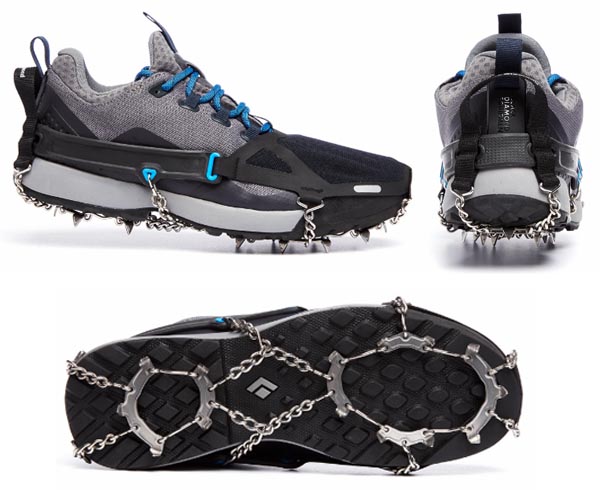
Specs:
- Number of Spikes (per foot): 14
- Spike length: 0.313”
- Weight (pair): 6.7oz
- Base: Chains
- Available at: Amazon
Review:
The Black Diamond Distance traction spikes were designed for trail running. However, they are also good for winter hiking in trail runners.
The harness has elastomer on the heels but a soft-shell front. The soft-shell material actually goes completely around your toe area, which adds a layer of warmth and keeps your feet from getting wet. Another perk of the soft-shell harness is that you don’t get any pressure points on your feet like you would wearing a standard elastomer harness with trail runners.
As for the spikes, they are 8mm (0.313”), which is a bit shorter than the Kahtoola Microspikes. You won’t feel them as much under your feet. There’s a front toe spike for good traction when running and uphill. The heel spikes are positioned a bit too far forward though, so the traction isn’t as good on the downhill.
If you want to wear these with hiking boots, you are better off getting the Black Diamond Access Spikes. They have the same traction base as the Distance spikes, but with an elastomer harness. Those weigh just 0.7oz more but fit boots much better. The soft-shell toe will probably break if you pull them over bulky boots.
Pros:
- Very lightweight
- Designed for trail runners
- Soft-shell toe cover
- Front toe spike
- Heel loop for easy on/off
Cons:
- Heel spikes too far forward- poor traction on downhill
- Don’t fit boots well
- Not many size options
- Pricy
Available at Amazon
4. Hillsound FlexSteps Traction System
Best for: Chainless traction for short hikes or walks around town
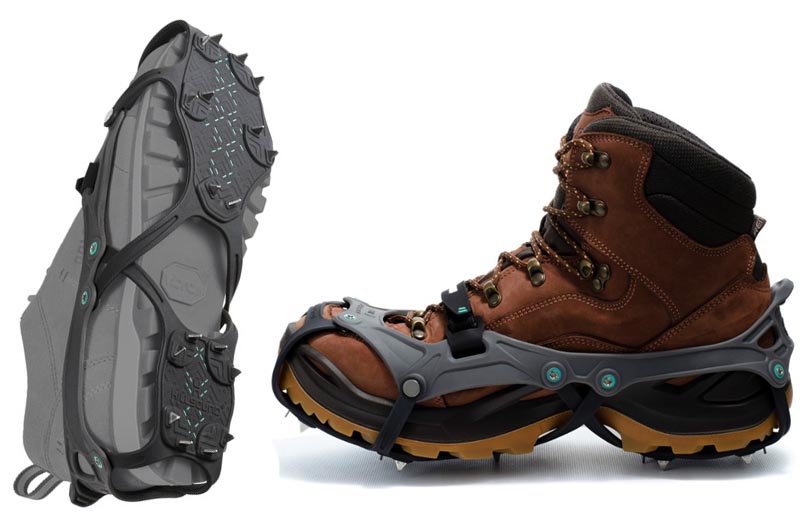
Specs:
- Number of Spikes (per foot): 18
- Spike length: 0.25”
- Weight (pair): 12.7oz
- Base: PU plate
- Available at: REI and Amazon
Review:
The FlexSteps are very different from the other microspikes reviewed here. They consist of 18 short spikes set in a polyurethane base. Some people will love this chainless design because it means that snow and ice doesn’t stick to them while you hike or walk. It also keeps the spikes from shifting like they would with chains.
But the PU base also means that the traction devices probably won’t last as long. If the base plate does crack or break, there’s no way of repairing them like you can with chains. Because of this, they aren’t the best option for long, serious treks. For shorter winter hikes or use around town, they are a very good option though.
Like with the Hillsound Trail Crampons, these have a Velcro strap over the toe area. It helps provide a very good fit. They are fairly easy to get on/off and actually feel comfortable on a variety of footwear types.
Pros:
- Shed snow well
- Great fit
- Easy to get on/off
Cons:
- No XS size
- Heavy
- No way to repair base
5. Kahtoola Exospikes
Best for: Packed snow and mixed terrain
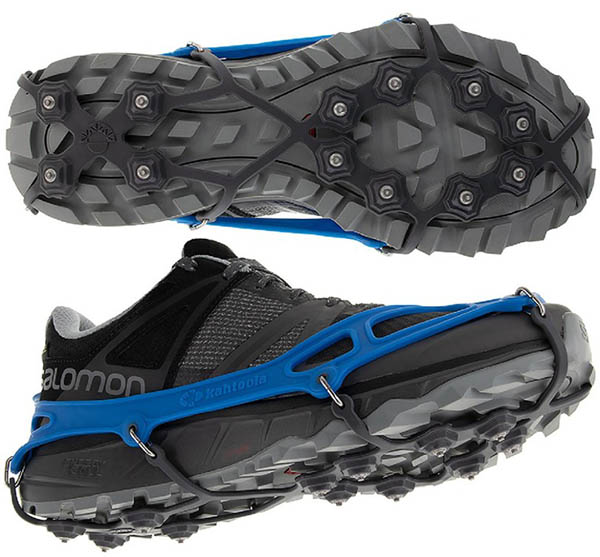
Specs:
- Number of Spikes (per foot): 12
- Spike length: 0.29”
- Weight (pair): 73oz
- Base: Hybrid
- Available at: REI and Amazon
Review:
If you mostly need traction for hiking on ice, then these are not the right devices for you. They are also terrible in loose snow because the spikes aren’t long enough to get traction. However, if you mostly encounter mixed terrain such as packed snow, some ice, rocks, thin mud and loose dirt, then these are a good option. They perform best in packed snow.
They are made with a thermoplastic polyurethane base that is supposedly sturdier than steel. From what users say, they actually are able to take a beating. The criss-cross design does a decent job of shedding snow and mud (and is better than chains in this sense).
The tungsten carbide tips are much harder and more durable than steel. It will take a very long time before they wear down. Unfortunately though, Kahtoola does not sell replacement tips for these and there’s no way to sharpen them. You’ll have to completely replace the traction system when they wear down.
Compared to other traction systems, these are a bit tricky to get on. The elastomer isn’t very stretchy, the toe tab is very small (especially with gloves on), and there isn’t anywhere to really grip them at the back.
Pros:
- Good at shedding snow
- Lightweight
- Can handle mixed terrain
Cons:
- Poor traction on ice
- Hard to get on/off
6. Snowline Chainsen Lights
Best for: Ultralight traction on a budget
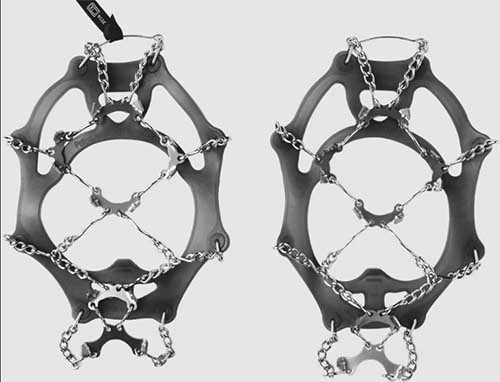
Specs:
- Number of Spikes (per foot): 12
- Spike length: 0.29”
- Weight (pair): 7.4oz
- Base: Chains
- Available at: Amazon
Review:
When it comes to affordable winter traction, the Snowline Chainsen Lights are always mentioned. Compared to other cheap options, these are definitely much better quality. These definitely don’t have the same quality as Hillsound or Kahtoola devices but – assuming you don’t wear them on rocky terrain – they hold up surprisingly well.
Other than the price, the main draw of these microspikes is that they are very lightweight. To get the weight down, they had to make the chains smaller. So, don’t be surprised if the chains bend or break if you aren’t careful. That can be fixed fairly easily with pliers though, but still don’t abuse these!
The level of traction is great with these and work well on ice, packed snow and loose snow too. Expect the spikes to wear down but you can sharpen them easily.
Unfortunately, these are a last-season product. Because of that, they are no longer available in a lot of stores.
Pros:
- Very affordable
- Easy to get on
- Lightweight
- Good traction
Cons:
- No XS size
- Don’t stay put well
- Don’t withstand abuse
Available at Amazon
7. Cimkiz Traction Spikes
Best for: Very tight budgets
Specs:
- Number of Spikes (per foot): 19
- Spike length: 0.5”
- Weight (pair): 17oz
- Base: Chains
- Available at: Amazon
Review:
This is one of the few generic brands of traction spikes which is actually a good quality. That said, they are still a cheap microspike. Don’t expect them to withstand abuse. You will need to take them off before going on rocky terrain. Otherwise you can expect the chains to quickly break.
If treated well though and only used as intended, you can actually hike a lot of miles in the Cimkiz. And it’s nice that they come with a Velcro strap for getting a good fit. The heel tab is actually large enough to make them easy to get on/off too.
Pros:
- Very cheap
- Velcro strap for good fit
- Easy to get on/off
Cons:
- Cheap quality
- Do not withstand abuse
Available at Amazon
Traction Types
Traction is divided into types based on the size and shape of its points Terminology sometimes gets used interchangeably or incorrectly, so I’ll go over them here.
Crampons:
- Several vertical sharp teeth attached with straps
- Teeth are usually at least 1 inch long
- Designed for climbing and steep alpine terrain
- Not for trekking
- Require safety training – easy to stab yourself with the spikes!
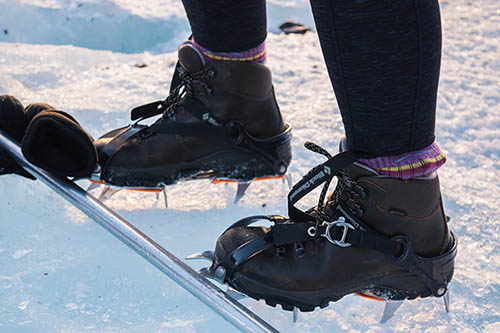
Notice the long (dangerous!) spikes on these crampons
Microspikes:
- Many vertical sharp teeth attached with chains or set on a plate
- Teeth are usually at ¼ to 1/2 inches long
- Meant for hiking or running on packed snow and moderately icy conditions
- Lower learning curve than crampons but still can injure oneself
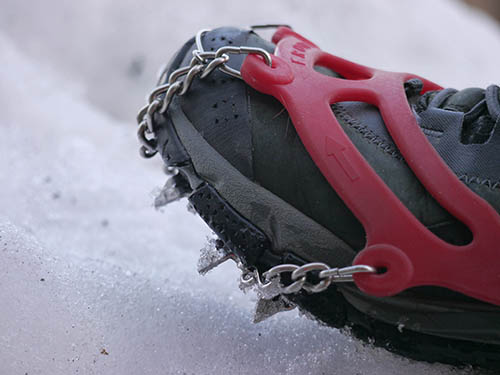
The teeth on microspikes are much shorter
Chains:
- Chains provide moderate amount of traction
- More comfortable than microspikes
- Meant for packed snow
- Not for steep or even hilly terrain
- Safe – no risk of injuring self like with spikes
Nanospikes, Cleats and Studs:
- Many small sharp points, set on a plate
- Points are less than ¼ inch long
- Usually meant for running or walking
- Not much traction
- Typically sized to fit over athletic shoes
- Lightweight
- Better for mixed terrain
Coils:
- Many metal coils wrapped around a rubber base
- Provide the least amount of traction
- Very lightweight
- Prone to failure
- Meant for walking on flat terrain
How to Choose Microspikes for Hiking
Amount of Traction
As a general rule, more spikes and larger spikes = better traction. If you want to get really technical though, you can start looking at the placement of the spikes too. For example, you might want microspikes with a point in the front toe area. This is useful if you need to engage your toes, such as pushing off when running.
Durability
Microspikes have to endure a lot of abuse. Even if you only use them as intended (on packed snow or moderately icy trails), the spikes are still subject to a lot of impact. And, realistically, most hikers do not wear microspikes are intended. They wear them on mixed terrain which consists of rocks and other hard surfaces.
Considering this, it’s no surprise that cheaply-made microspikes quickly break. For example, the cheap YakTrax usually have a rubber band holding the traction in place. The spikes move out of position easily. Not only is this uncomfortable, but it means there is bigger impact on some spikes. The spikes can completely break off. The rubber also hits the ground and is subject to abrasion, so can break. You can end up with spikes that completely break off.
It’s really important you get durable microspikes. Yes, they are more expensive but they last you longer. Plus, it could be a massive safety risk if your traction breaks mid-hike!
Signs of Durable Microspikes:
- Hardened stainless steel: These will last much longer before they start wearing down.
- Metal plate or chains: These are more durable than microspikes with rubber or plastic plates holding the spikes in place.
- Multiple chains connecting spikes: The more chains connecting the spikes, the more likely they are to stay in place instead of shifting. This helps distribute the impact better so the microspikes are less likely to break.
- Reinforced eyelets on harness: So the chains don’t tear out of the harness
- Rubber temperature rating: Good brands of microspikes use rubber harnesses which are rated for cold weather. They will remain flexible even in extreme cold, and thus the harnesses are less likely to crack or break.
Hillsound, Snowline and Black Diamond are all good brands for microspikes. But, by far, Kahtoola microspikes are known for their durability. They can endure insane amounts of abuse.
Note: Even if the best brands of microspikes, the spikes will still eventually dull and wear down over time. But you should be able to get at least 200-300 miles out of a good durable pair!
Tip: Always carry a few zip ties and some paracord with you. If the microspikes break, you’ll be able to repair them well enough to get you back to the trail head.
Size and Fit
Getting the right size is really important with microspikes. It’s not just a matter of comfort but safety: if they are too large, your footwear will slip around. If they are too small, they will pull upwards on your feet and make you less stable.
Think carefully about what type of shoes you are going to wear with the microspikes. Obviously you are going to need larger sized microspikes for bulky boots versus trail runners.
Tip: Look for toe bails. This is a piece of steel at the toe area. It prevents your boots from pushing through the chains.
Base Type
The spikes on traction devices need to stay put underneath your feet. If they move around, you will experience slippage. Spikes which move around also won’t equally absorb impact, so are more likely to break.
There are three ways that spikes are held in place: chains, plates or hybrid bases.
Chains:
- Chains connect individual or sets of spikes.
- Most likely to move and slip
- Don’t shed snow or mud well
- The chains themselves provide some traction
- It’s possible to fix broken chains
Plates:
- Consist of flat plate (usually polyurethane) with spikes set on it
- Spikes stay in place
- Shed snow and mud well
- Usually very comfortable
- Base prone to cracking
- No way to fix broken plate
- Harder to get on
Hybrid:
- Consist of several plates connected by chains or polyurethane
- Spikes stay in place very well
- Fewer chains
- Good balance between durability and stability
Harness
Almost all microspikes have harnesses made out of elastomer (aka polymer elastic). This material is flexible and stretchy, so it is easy to pull over your footwear and stays in place well.
Not all elastomers are created equally though. The cheap ones aren’t as stretchy or will lose their stretch, so won’t stay in place well. In cold temperatures, they will easily crack and break. Once it breaks, there’s no way to fix it. This is one more reason to buy microspikes from trusted brands which use good-quality materials.
Pro Tip: Get microspikes which have a Velcro strap over the harness. This lets you adjust the fit of the microspikes so they don’t shift around on your footwear. It’s also sometimes possible to DIY the Velcro strap yourself.
Stainless Steel vs. Carbon Spikes
Most microspikes have either hardened stainless steel or hardened carbon steel spikes. Of the two, carbon steel is much more durable. However, carbon steel rapidly corrodes when exposed to salt. You do not want to use these on city streets or anywhere that salt is used!
How Easy they Are to Get On/Off
When hiking on mixed terrain, you may need to take your microspikes on/off multiple times. This can be incredibly annoying – especially with gloves on in freezing temperatures. Some models of microspikes have a pull tab on the heel area to make this easier.
Weight
For all the ultralight backpackers out there, please don’t let weight dictate which microspikes you get. Light weight generally means less traction and a harness which is more likely to slip around. Don’t risk your safety in order to save an ounce or two!
Instead, think about what type of terrain you are going to encounter and what the lightest microspikes suitable to that terrain is.
Cost
I am a big believer that you don’t need to have expensive gear to go hiking. But there are some places where you simply shouldn’t skimp on gear – and that includes safety gear like microspikes.
Saving $20 isn’t worth it if it means you risk falling off a mountain!!!
Aside from the safety issue, it’s almost inevitable that cheap microspikes will break. Microspikes have to endure a lot of abuse and ones with poor construction will not hold up. There are countless stories on forums and Reddit of generic brand microspikes breaking mid-hike. Like this Reddit comment:
My friend had some $20 ones and they lasted about an hour. We had to cut our trip short and turn around after they broke.
Not only does this ruin the hike, but you’ll then have to buy another pair of microspikes. The phrase goes, “I’m too poor to buy cheap stuff.”
There is an exception here though: If you only need microspikes for easy, flat terrain (such as when shoveling your driveway), then the cheap microspikes are fine. But, if the success of your hiking trip depends on having good traction, spend the extra money to buy from a reputable brand.
Pro Tip:
Microspikes are infamous for causing rips in pants. When hiking in a new pair of microspikes for the first time, make sure you’ve got good pair of reinforced gaiters on. And maybe don’t wear your favorite pair of hiking pants!
Sources:
https://www.reddit.com/r/socalhiking/comments/kwmck1/what_brand_microspikes/,
https://blog.dahlstromrollform.com/coastal-construction-correct-metal,
https://www.industrialspec.com/about-us/blog/detail/what-are-elastomers-rubbers-elastomeric-material,
https://www.reddit.com/r/Ultralight/comments/jxny9s/microspikes_recommendations/,
https://www.reddit.com/r/Ultralight/comments/jxny9s/microspikes_recommendations/
Image credits:
“Kahtoola Microspikes & Kahtoola LevaGait” (CC BY-NC 2.0) by Bill in Arizona
“Teeth” (CC BY 2.0) by grongar
“Crampons” (CC BY-NC 2.0) by jev55
“Trail blaze on Giant Ledge” (CC BY-SA 2.0) by ke9tv


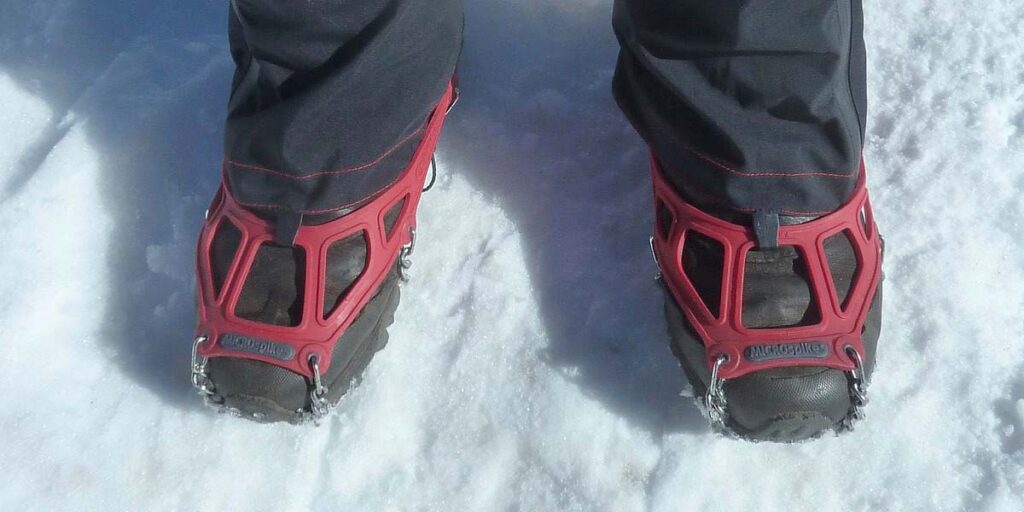
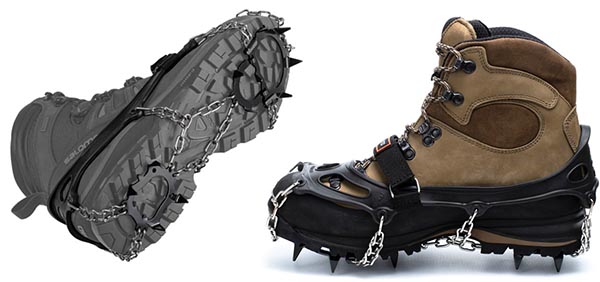
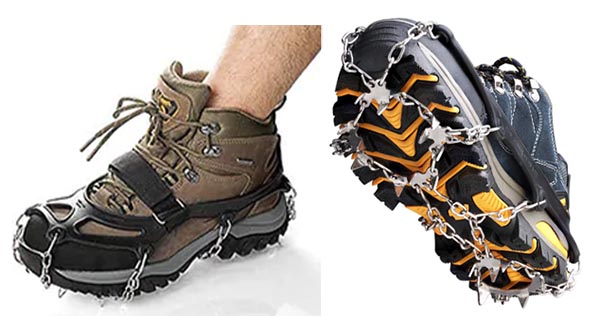
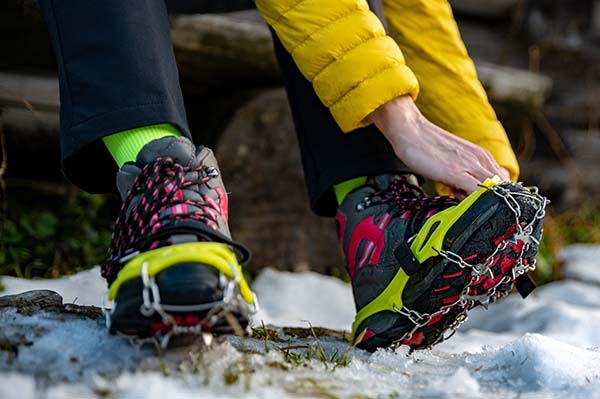










Post your comments